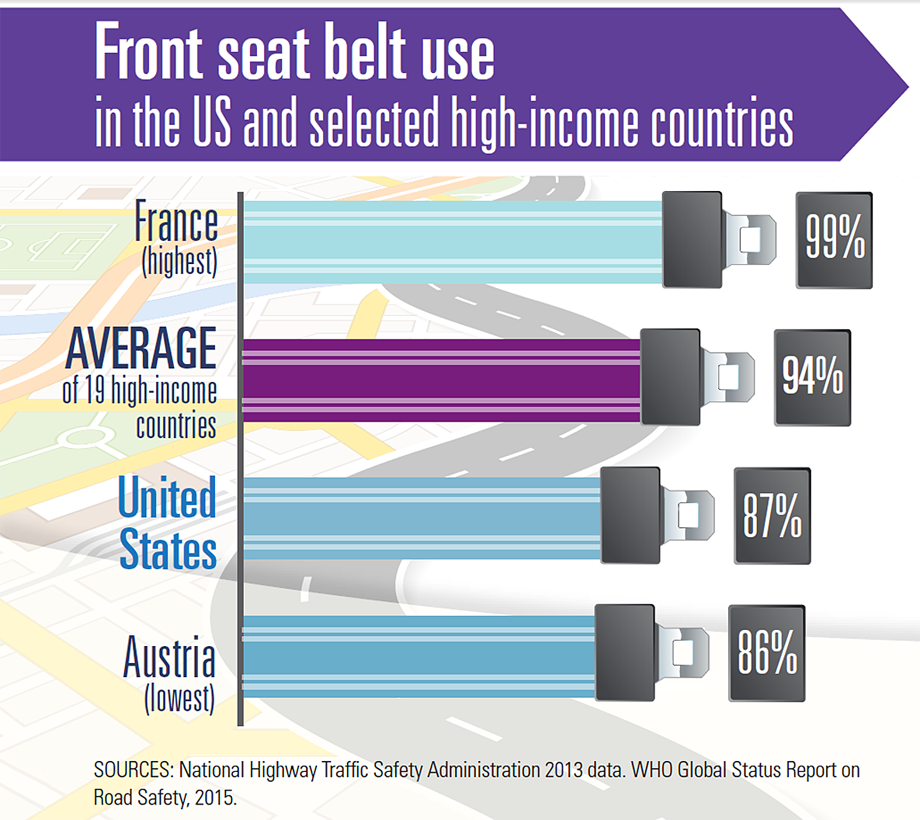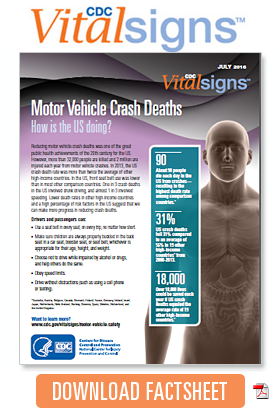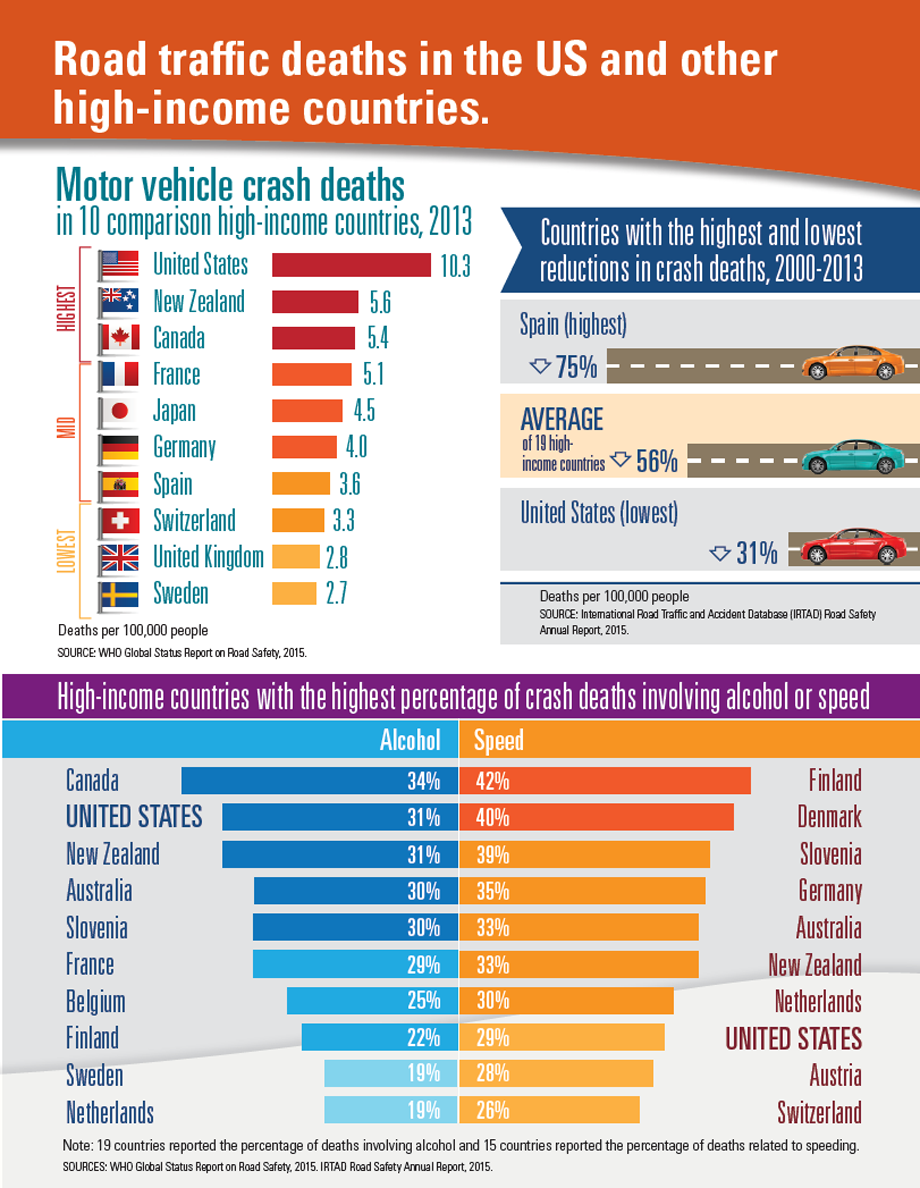Vital Signs: Motor Vehicle Crash Deaths
How is the US doing?
Reducing motor vehicle crash deaths was one of the great public health achievements of the 20th century for the US. However, more than 32,000 people are killed and 2 million are injured each year from motor vehicle crashes. In 2013, the US crash death rate was more than twice the average of other high-income countries. In the US, front seat belt use was lower than in most other comparison countries. One in 3 crash deaths in the US involved drunk driving, and almost 1 in 3 involved speeding. Lower death rates in other high-income countries and a high percentage of risk factors in the US suggest that we can make more progress in reducing crash deaths.
Drivers and passengers can:
- Use a seat belt in every seat, on every trip, no matter how short.
- Make sure children are always properly buckled in the back seat in a car seat, booster seat, or seat belt, whichever is appropriate for their age, height, and weight.
- Choose not to drive while impaired by alcohol or drugs, and help others do the same.
- Obey speed limits.
- Drive without distractions (such as using a cell phone or texting).

About 90 people die each day in the US from crashes— resulting in the highest death rate among comparison countries.*
US crash deaths fell 31% compared to an average 56% in 19 other high—income countries* from 2000-2013.
Over 18,000 lives could be saved each year if US crash deaths equaled the average rate of 19 other high—income countries.*
*Australia, Austria, Belgium, Canada, Denmark, Finland, France, Germany, Ireland, Israel, Japan, Netherlands, New Zealand, Norway, Slovenia, Spain, Sweden, Switzerland, and the United Kingdom.
Motor vehicle crash deaths in the US are still too high.
There were more than 32,000 crash deaths in the US in 2013. These deaths cost more than $380 million in direct medical costs.
Major risk factors for crash deaths in the US.
- Not using seat belts, car seats, and booster seats contributed to over 9,500 crash deaths.
- Drunk driving contributed to more than 10,000 crash deaths.
- Speeding contributed to more than 9,500 crash deaths.
Reducing major risk factors could save thousands of lives and hundreds of millions of dollars in direct medical costs each year.
Seat belts saved over 12,500 lives in the US in 2013, yet:
- The US had lower-than-average front and back seat belt use compared with other high-income countries.
- About half of drivers or passengers who died in crashes in the US weren’t buckled up.
Some proven measures of best performing high-income countries.
Even when considering population size, miles traveled, and number of registered vehicles, the US consistently ranked poorly relative to other high-income countries for crash deaths. Some of the best performing countries:
- Have policies in line with best practices, including those that address:
- Primary enforcement of seat belt laws that cover everyone in every seat.
- Police officers can stop a vehicle and write a ticket for anyone not buckled up.
- Requirements for car seats and booster seats for child passengers through at least age 8.
- Blood Alcohol Concentration (BAC) levels.
- US, Canada and the United Kingdom define drunk driving as BAC levels at 0.08% or above; all other comparison countries use lower BAC levels (0.02-0.05%).
- Primary enforcement of seat belt laws that cover everyone in every seat.
- Use advanced engineering and technology, such as:
- Ignition interlocks for all people convicted of drunk driving.
- This device keeps the vehicle from starting unless the driver has a BAC below a pre-set low limit.
- Automated enforcement, for example, speed and red light cameras.
- Improvements in vehicle safety and transportation infrastructure.
- Ignition interlocks for all people convicted of drunk driving.
- Implement proven measures, such as:
- More use of publicized sobriety checkpoints.
- Maintain and enforce the minimum legal drinking age.

The Federal government is
- Tracking the nation’s progress in reducing crash injuries and deaths.
https://wwwn.cdc.gov/psr/NationalSummary/NSMVI.aspx - Evaluating and encouraging the use of proven programs and policies.
www.thecommunityguide.org/mvoi/index.html
www.nhtsa.gov/staticfiles/nti/pdf/812239_Countermeasures_8thEd_TT.pdf - Collaborating with and providing guidance, resources, and tools for motor vehicle injury prevention to state, local, tribal, and federal partners.
www.cdc.gov/motorvehiclesafety/
Drivers and passengers can
- Use a seat belt in every seat, on every trip, no matter how short.
- Make sure children are always properly buckled in the back seat in a car seat, booster seat, or seat belt, whichever is appropriate for their age, height, and weight.
- Choose not to drive while impaired by alcohol or drugs, and help others do the same.
- Obey speed limits.
- Drive without distractions (such as using a cell phone or texting).
States can
- Increase seat belt use with primary enforcement seat belt laws that cover everyone in the vehicle.
www.cdc.gov/psr/national-summary/mvi.html - Consider requiring car seats and booster seats for children through at least age 8 or until seat belts fit properly.
www.cdc.gov/motorvehiclesafety/seatbelts/states.html - Reduce drunk driving by:
- Expanding publicized sobriety checkpoints.
https://www.thecommunityguide.org/findings/motor-vehicle-injury-alcohol-impaired-driving-publicized-sobriety-checkpoint-programs - Enforcing existing 0.08% blood alcohol concentration (BAC) laws and minimum legal drinking age laws.
https://www.thecommunityguide.org/findings/motor-vehicle-injury-alcohol-impaired-driving-maintaining-current-minimum-legal-drinking-age - Considering ignition interlock requirements for people convicted of drinking and driving, starting with their first offense.
www.cdc.gov/motorvehiclesafety/impaired_driving/ignition_interlock_states.html
- Expanding publicized sobriety checkpoints.
- Support traffic safety laws with media campaigns and visible police presence to increase restraint use and decrease impaired driving and speeding.
- Consult CDC’s Motor Vehicle Prioritizing Interventions and Cost Calculator for States (MV PICCS) to find out the cost of implementing up to 14 interventions and the number of injuries prevented and lives saved.
www.cdc.gov/motorvehiclesafety/calculator/index.html - Consider implementing Vision Zero—a road safety approach that considers death and severe injuries on our roads unacceptable and preventable.
https://visionzeronetwork.org/
Health care providers can
- Give patients resources about motor vehicle safety and remind them how important it is to use a seat belt on every trip.
- Counsel parents and caregivers on using age and size-appropriate car seats, booster seats, and seat belts on every trip.
www.cdc.gov/Motorvehiclesafety/Child_Passenger_Safety/index.html - Talk to patients about the dangers of impaired driving and help identify counseling options as needed.
- Provide parents and caregivers of teens with resources on safe teen driving.
www.cdc.gov/parentsarethekey/peds/index.html
Issue Details
- Vital Signs Issue details: Motor Vehicle Injury Prevention, Morbidity and Mortality Weekly Report (MMWR)
- Vital Signs – Motor Vehicle Crash Deaths [PODCAST – 1:15 minutes]
- Vital Signs – Motor Vehicle Crash Deaths [PSA – 0:60 seconds]
- CDC: Motor Vehicle Safety
- CDC: State-based Costs of Motor Vehicle Crash Deaths
- Vital Signs: Motor Vehicle Crash Injuries
- Vital Signs: Child Passenger Safety
- CDC: Child Passenger Safety
- CDC: Seat Belts
- CDC: Impaired Driving
- CDC: Increasing Alcohol Ignition Interlock Use: Successful Practices for States
- Sobering Facts: Drunk Driving State Fact Sheets
- CDC: Teen Drivers
- CDC: Global Road Safety
- Prevention Status Reports: Motor Vehicle Injuries
- The Community Guide: Motor Vehicle-Related Injury PreventionExternal
- CDC WISQARS (Web-based Injury Statistics Query and Reporting System)
- CDC: Motor Vehicle PICCS (Prioritizing Interventions and Cost Calculator for States)
- MedlinePlus – Motor Vehicle SafetyExternal
- MedlinePlus – Impaired DrivingExternal
- World Health Organization: Global Status Report on Road Safety 2015External
- Vision Zero NetworkExternal
- Road to Zero National EffortExternal
- Safe Kids Worldwide: Find a Child Passenger Safety TechnicianExternal
- Substance Abuse and Mental Health Services Administration: The Dangers of Underage Drinking and DrivingExternal
- NHTSA – Countermeasures That WorkCdc-pdfExternal


